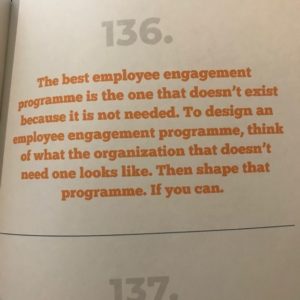Here are three baskets full of concepts:
Basket one: Working conditions, Flexibility at work, Pay and perks, Reward and recognition, Empowerment, Good communication, People development plans, Talent management, Clear vision and purpose, Internal digital connections, Gamification, and Health & wellbeing programme.
Here is basket 2: Satisfaction, Happiness, Engagement, Fun, Self belief, Realization ,Enhancement. Fulfilment, and Motivation.
And basket 3: Profitability, Higher EPS, Retention, Reputation, Customer satisfaction, Loyalty, Employer of choice, Low absenteeism, Safety, High quality, and Resilience in adversity.
Pick one from basket 1, say that it produces something from basket 2 (pick one concept ), which, in turn, delivers something from basket 3 (pick one or two). You can’t go wrong. And I bet you will always find some data with correlations between the items in each basket. Flexibility at work (basket one) creates high motivation (basket two) which leads to low absenteeism. Come on, give it a try. The combinations are great.
Constructing Employee Engagement arguments is not difficult at all. There are always correlations between items from basket 1 and 3, or 1 and 2, or 2 and 3 etc. Problem is, these are correlations, not causality. Most Employee Engagement arguments that we use in organizations are semi-rich in correlations and very weak in causality. The truth is that it is hard to tell, for example, whether satisfaction delivers profitability, or profitability delivers satisfaction. The fact that we may see both going together does not make the casual argument in one direction true.
Many Employee Engagement systems and questionnaires are based upon the assumption of something from conceptual basket one, delivering something from basket two and/or three. We have taken the argument at face value. We have converted correlation into causality. But, as the Spurious Correlations website reminds us, there is also a strong correlation between the per capita consumption of mozzarella cheese in the USA and the number of civil engineering doctorates awarded. Or the divorce rate in the state of Maine, correlating highly with the per capita consumption of margarine.
Whilst most sensible people would not infer that feeding your son with mozzarella cheese will make it highly probable that he will get a Civil Engineering doctorate, or that a decrease in divorce requires banning margarine, many managers would be very happy with declaring as true causality chain the correlation between anything in basket one with anything in basket two and/or three. The whole industry of Employee Engagement is based upon this.
When I show these arguments, sometimes to large audience in my Speaking Engagements, I get the whole spectrum of reactions. The data-fundamentalists get very irritated, despite the fact that they can’t really show serious causality data. The ‘Employee Engagement people’, furnished with all their questionnaires, get even more irritated. The Cynical contingency says that what I am inferring is that we should not do anything, not bother at all about Employee Engagement initiatives, because all data is flawed.
But the latter is far from my position. I think we should do anything we believe that will improve the company, period. It’s called Good Management, and I am all for it. But managers need to use their critical thinking more. Do as much as needed for good management, and avoid the simplistic causality interpretation of input-output: if we do more Town Hall meetings with all employees, it will give them more ‘voice’ and air time, it will improve their morale and that will increase performance. The company is not an input-output machine. For goodness say, lets do what we believe we need to do without the constant need to justify the output! Maybe it is morally good, managerially sound and probably beneficial for the mental health of all, to give employees more airtime, more voice, more saying and a more proactive role. Do you need a score in a questionnaire to tell you that you should do that?
By the way, here is another one: the number of films Nicolas Cage appeared, correlated highly with the number of people drowned by falling into a swimming pool. He should really stop his movie career, or else, we will need to have compulsory fences around pools.
________________________________________________________________________________________________
Extract from: The Flipping point – Deprogramming Management.
Making ‘employee engagement’ work has always been called management. The fact that we needed to create an extra programme for it, tells you a lot about the strength of management itself.’




Would you like to comment?